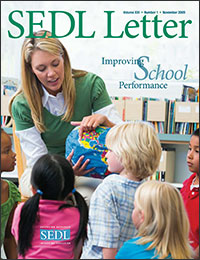Building Bright Futures for Preschoolers in Madison Parish
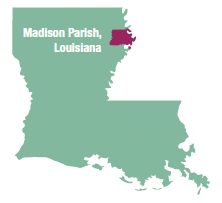 Like many rural areas in the United States, Madison Parish has its share of economic problems—high poverty, abandoned and blighted properties, and limited job opportunities. A largely agricultural area in Northeast Louisiana, Madison may appear to have little to offer. But a closer look reveals a different picture—scenic landscapes, a rich past, and lots of hope for the future. Tallulah—the seat of Madison Parish—had the state’s oldest airport and was the first U.S. city to build an indoor mall (National Register of Historic Places, n.d.). In the early 1900s, the U.S. Department of Agriculture established Delta Laboratory in Tallulah as a base for groundbreaking insect research and aircraft dusting experiments. At the urging of the lab’s director, the crop-dusting company Huff Daland Dusters moved its headquarters to nearby Monroe and eventually evolved into present-day Delta Airlines (Delta Heritage Museum, n.d.).
Like many rural areas in the United States, Madison Parish has its share of economic problems—high poverty, abandoned and blighted properties, and limited job opportunities. A largely agricultural area in Northeast Louisiana, Madison may appear to have little to offer. But a closer look reveals a different picture—scenic landscapes, a rich past, and lots of hope for the future. Tallulah—the seat of Madison Parish—had the state’s oldest airport and was the first U.S. city to build an indoor mall (National Register of Historic Places, n.d.). In the early 1900s, the U.S. Department of Agriculture established Delta Laboratory in Tallulah as a base for groundbreaking insect research and aircraft dusting experiments. At the urging of the lab’s director, the crop-dusting company Huff Daland Dusters moved its headquarters to nearby Monroe and eventually evolved into present-day Delta Airlines (Delta Heritage Museum, n.d.).
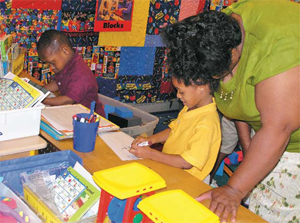 Preschoolers work in the writing center while a paraprofessional engages them in conversation about their work.
Preschoolers work in the writing center while a paraprofessional engages them in conversation about their work.
Today, Madison Parish is pioneering work of a different kind. Nestled among fragrant magnolias and towering oaks are three preschool centers working together to build bright futures for students in their community. Madison Parish Public Schools (MPPS) has partnered with Delta Community Action Association-Tallulah Head Start and SEDL to create the Bright Futures Early Reading First (ERF) Project, which oversees the centers. Bright Futures is a multiyear initiative to improve the school readiness of prekindergarten students from low-income homes while providing high-quality professional development to teachers and paraprofessionals. MPPS was the first Louisiana district to receive ERF funding from the U.S. Department of Education in 2007.
Patricia Candler, assistant superintendent/chief academic officer of MPPS, serves as project director of Bright Futures and works with other key personnel, including management staff from Delta Community Action Association-Tallulah Head Start, an ERF coordinator, three ERF reading coaches, a parent involvement coordinator, and several SEDL consultants. “Our biggest challenges have been coordinating three preschool centers at separate sites and improving classroom environments, as required by the ERF grant,” says SEDL program associate Kathleen Theodore, who is providing literacy professional development in Madison Parish. “Management team meetings have helped in the process of becoming one center at three sites.”
The Role of Research-Based Curriculum and Professional Development
The mission of ERF is to ensure that all children enter kindergarten with the necessary language, cognitive, and early reading skills for continued success in school. Research suggests that nearly all students can become competent readers, but they need high-quality instruction at an early age (National Research Council, 2000). Success in narrowing the achievement gap among students in low socioeconomic groups depends on providing young children with specific knowledge in preschool curricula before they start kindergarten (Klein & Knitzer, 2006). To ensure their students are ready for kindergarten, Bright Futures leaders have implemented a common curriculum of research-based instructional programs in the preschool centers. The curriculum includes methods to develop oral language that focus on word play, listening and responding to literature selections, and vocabulary development exercises. Also, the instructional programs help ensure that children with special needs or disabilities receive additional targeted instruction that is informed by regular assessment to meet individual needs.
Kathleen Theodore (in center), a SEDL program associate, models and facilitates a study group with teachers and Early Reading First staff at Tallulah Elementary.
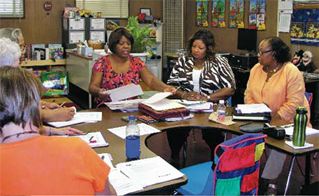
Bright Futures seems to be having a positive impact on instruction and learning at the preschool centers. A recent peek into a classroom at Tallulah Elementary School revealed a teacher working with preschoolers during whole-group instruction time. Most of the students smiled shyly, while some gave little waves. As the teacher began calling out letters, the children all raised their hands to point to the correct answers on the alphabet chart. Also, the students introduced themselves by saying, “My name is ____________. I am ____ years old. I am a ____ (boy or girl), and I am happy to be here,” demonstrating their oral language skills by speaking clearly and in complete sentences. At Delta Head Start (DHS), preschoolers were busy clapping and singing during circle time, listening to stories in Read Aloud, and zooming down raceways in the developmental center.
“Children are actively engaged and learning and loving it,” says Corine Holmes, ERF reading coach at Tallulah Elementary. “One of the biggest impacts has been the partnership between the two district schools [Wright and Tallulah] and the Delta Head Start center. I can see growth in the 3-year-olds from DHS as they enter into the district’s 4-year-old preK program. Their oral language and expression are exceptional. They also follow oral directions well, and their early writing skills are on target.”
In addition to establishing a common curriculum and a print-rich classroom environment at the preschool centers, Bright Futures provides more than 220 hours of intensive, ongoing professional development annually for principals, teachers, and reading coaches. Since Fall 2007, SEDL’s Theodore has worked closely with teachers and project staff to provide focused training in language, cognitive, and early reading development that will improve preschoolers’ oral language, phonological awareness, print awareness, and alphabet knowledge. Recently, she conducted a study group for preschool teachers at Wright Elementary to evaluate data (samples of student work). The group reviewed anonymous self-portraits and renderings of letters, numbers, and figures to get a sense of the children’s developmental and skill levels. Teachers shared thoughts on what the work conveyed and ideas for related lessons, as well as ways to help students move forward in prereading literacy skills. The group expressed positive feedback on the session and requested more information on the process.
Before the study group session, Theodore and SEDL program associate Stacey Joyner modeled the process for the ERF coordinator and reading coaches, who will conduct additional sessions at their preschool centers. “The coaching process has supported classroom teachers by modeling, demonstrating, and facilitating study groups,” says Rena Lucas, ERF reading coach at DHS. “With the support of SEDL, professional development and other resources have allowed me to provide followup for teachers.”
In addition to providing targeted support and helping with project oversight, Theodore has offered teachers 3-day summer institutes that focus on scientifically based early literacy instruction, grade-level expectations, the Head Start Child Outcomes Framework, implementation of the reading programs, and the use of assessments to inform instruction. “The research strategies that we’ve used have helped us align our preK to kindergarten programs so that our students are having greater literacy success,” says Nancy Smith, ERF coordinator. “The district preK teachers have commented that the children transitioning from the Head Start program are much better prepared than children who have not previously attended school.”
Involving Families and Community
Another key focus of Bright Futures is increasing parent engagement both at school and at home. In Spring 2008, the first Family Literacy Night was held at Tallulah Elementary, during which parents learned about literacy activities, created take-home activities with their children, and observed a group book-reading experience. More than 70 parents attended with their children, and 90% of those who completed the evaluation indicated that they were more likely to do similar activities with their children at home after attending the literacy night. Staff members also planned a literacy night for Fall 2009 and expected an even larger turnout, based on participants’ feedback.
To continue these efforts, Chris Ferguson, a SEDL program associate, is collaborating with Pat Buchanan, ERF parent involvement coordinator, to plan literacy activities that educate parents in the skills that support their child’s development, are responsive to the family’s language and culture, and engage the entire community in supporting literacy. Ferguson has conducted staff training and coaching in strategies for increasing parent engagement. “While this work with parents is vital to the success of the project, the efforts to engage the larger community in the literacy work are also important,” says Ferguson. “In a community such as Madison Parish, which has a long history of poverty and low [academic] performance, implementing literacy improvement throughout the system is central to sustained improvement and to building a culture of shared responsibility for student literacy.”
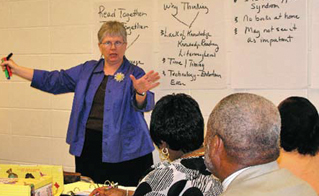
Chris Ferguson, a SEDL program associate, facilitates a community- and parent involvement planning meeting.
Since May 2008, SEDL staff have supported parish staff in activities that engage businesses, faith-based organizations, community organizations, support agencies, and individuals in exploring their role in supporting literacy outside of school. In September 2009, SEDL staff facilitated an intense conversation with key community stakeholders on how to move their “talk to action,” in the words of Reverend Theodore Lindsey. In coming months, Madison Parish staff, parents, and the community plan to move forward with this initiative.
Seeing Results
SEDL’s Research and Evaluation work group has been instrumental in supporting Bright Futures by evaluating the implementation efforts and the impact of the project. SEDL staff have maintained a student assessment database for tracking the progress of student outcomes over time and have collected baseline data. Sarah Caverly, a SEDL program associate, has trained teachers and project staff on administering assessments, analyzing assessment data, and using assessment data to make instructional decisions. She and colleagues also have completed periodic site visits to the preschool centers to interview teachers, conduct classroom observations, and coordinate data collection and management of student assessment data.
Many of the evaluation results are encouraging. Using the assessments and evaluation data, SEDL has identified strategies for improvement and worked with Bright Futures staff to strengthen classroom environments and resources to support early literacy and language development. “Results on classroom resources compared to baseline data show significant growth as measured by the Early Language and Literacy Observation Tool,” explains Caverly. “Results on the classroom environment quality were in the basic-to-strong range.”
SEDL staff also have conducted evaluation activities to guide ongoing improvement, measure child outcomes, and contribute to the knowledge base in the field of early childhood education. In Fall 2007 and Spring 2008, students were assessed in vocabulary skills, phonological awareness, print awareness, and alphabet knowledge in pre- and post-tests. Preschoolers have shown statistically significant improvement in all four areas. While lacking control-group comparisons, “early indications are promising, particularly regarding teachers making critical structural changes to their classroom environments to support and enrich literacy activities in their classrooms,” says Michael Vaden-Kiernan, director of Research and Evaluation at SEDL.
In Year 3 of Bright Futures, SEDL will continue its work in the partnership by
- conducting quarterly leadership trainings for management, project staff, and preschool center personnel;
- providing data-driven, targeted assistance and training for teachers and coaches;
- providing intensive training on how to administer, collect, interpret, and use assessment data; and
- assisting with development of a series of parent and community events to demonstrate and provide hands-on training for participants on their role in supporting literacy.
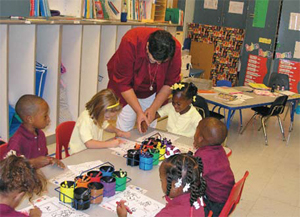
Students participate in small-group writing activities with a paraprofessional.
“During the duration of the program, both teacher practice and student performance have shown tremendous growth,” says Candler. “The classroom environments of all the Early Reading First teachers continue to improve as materials are purchased and put in place through the guidance of SEDL consultants, the director, the coordinator, and coaches. Also, coaching has shown to be valuable in changing teachers’ classroom practices.”
Based on progress so far, Madison Parish has taken key steps in building bright futures for preschoolers in rural Louisiana.
References
- Klein, L., & Knitzer, J. (2006). Pathways to early school success: Effective preschool curricula and teaching strategies (Issue Brief No. 2). New York, NY: National Center for Children in Poverty.
- Lecky, C. S., & Murphy, M. S. (1936). History of Tallulah laboratory, Bureau of Entomology, U.S. Department of Agriculture. Retrieved from www. rootsweb.ancestry.com/~lamadiso/articles/ bughistory.htm
- National Register of Historic Places. (n.d.). Louisiana–Madison County. Retrieved from www.nationalregisterofhistoricplaces.com/LA/ Madison/state.html
- National Research Council, Committee on Early Childhood Pedagogy. (2000). Eager to learn: Educating our preschoolers. B. Bowman, S. Donovan, & S. Burns. (Eds.). Washington, DC: National Academy Press.
- The Delta Heritage Museum. Delta History: Facts. A history of service. (n.d.). Retrieved from http://deltamuseum.org/M_Education_DeltaHistory_ Facts_History.htm
- U.S. Department of Commerce, Bureau of Economic Analysis. (2009). BEARFACTS 1997–2007, Madison, Louisiana (22065). Retrieved from www. bea.gov/regional/bearfacts/action.cfm?FIPS=22065
Next Article: Helping Texas Teachers Support English Language Learners
